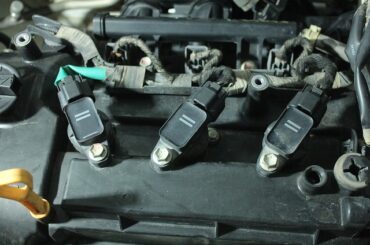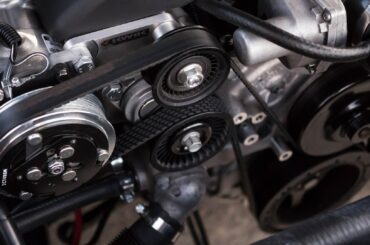Contents
How to Clean a Serpentine Belt – Introduction

The serpentine belt in your vehicle is more than just a mundane piece of rubber; it’s a crucial component of the engine’s accessory drive system. This belt is responsible for powering vital components such as the alternator, air conditioning compressor, power steering pump, and more. Over time, the serpentine belt can accumulate dust, oil, and debris, which may hinder its performance and, ultimately, shorten its lifespan. Cleaning the serpentine belt is a straightforward maintenance task that can significantly impact the longevity and functionality of this essential component.
Belt Squeek Methods – Diag and Cleaning – Quick – DIY – Only Follow if you know what you’re doing: https://m.youtube.com/watch?v=OFInjED_KD4&pp=ygUeSG93IHRvIENsZWFuIGEgU2VycGVudGluZSBCZWx0
Step-by-Step Guide to Cleaning a Serpentine Belt:
1. Prioritize Safety: Your safety is paramount. Ensure the engine is off and has had sufficient time to cool down. Working on a hot engine can result in burns or other injuries. As an additional safety measure, disconnect the negative terminal of the car’s battery to prevent any accidental engine starts.
2. Locate the Belt: Find the serpentine belt in your vehicle. It is typically a long, winding belt that snakes around various pulleys. If you’re unsure about its exact location, consult your vehicle’s manual or look for online resources that provide detailed diagrams.
3. Inspect for Damage: Before proceeding with cleaning, conduct a visual inspection of the serpentine belt. Look for signs of cracks, wear, or damage. If you notice significant wear or visible damage, cleaning may not be sufficient, and you should consider replacing the belt.
4. Gather Cleaning Supplies: You’ll need a clean cloth or rag and a mild detergent solution. It’s essential to choose a detergent that is non-abrasive and won’t harm the belt’s material.
5. Cleaning: Dip the cloth or rag into the detergent solution, ensuring it is not overly saturated. Gently wipe down the surface of the serpentine belt. Thoroughness is key, but be cautious not to apply excessive force, as this could damage the belt. Wipe along the entire length of the belt to remove dust, oil, and debris.
6. Rinse: After cleaning, thoroughly rinse the cloth or rag to eliminate any detergent residue. Wipe the belt again with a clean, damp cloth to remove any remaining soap or lingering debris.
7. Dry Thoroughly: It’s crucial to allow the belt to air dry completely before starting the engine. Ensure that there is no moisture left on the belt, as water can reduce traction and affect the belt’s performance.
8. Reconnect the Battery: If you disconnected the car’s battery earlier, reconnect the negative terminal.
9. Start the Engine: Once the serpentine belt is completely dry and the battery is reconnected, start the engine to verify that the belt is functioning correctly. Listen for any unusual noises and observe the belt for signs of slipping or wobbling.
Precautions:
– While cleaning the serpentine belt, gentle handling is crucial. Excessive force can harm the belt or cause it to slip off the pulleys.
– Harsh or abrasive detergents should be avoided at all costs, as they can damage the belt’s material.
– If you detect significant damage or wear during the inspection, it’s advisable to replace the serpentine belt rather than attempting to clean it.
– Always ensure that the engine is completely cool and turned off before initiating the cleaning process.
When to Clean a Serpentine Belt:
Cleaning a serpentine belt should ideally be part of your regular vehicle maintenance routine. Regular cleaning can help maintain the belt’s performance and extend its life by preventing the accumulation of dirt and debris.
However, it’s essential to recognize that cleaning a serpentine belt should not be seen as a long-term substitute for inspections and eventual replacement. All belts have a finite lifespan, and no amount of cleaning can reverse the effects of wear and tear. If you notice signs of damage or the belt is approaching the end of its service life, it’s advisable to consider replacing it as part of your vehicle’s routine maintenance.
The Benefits of a Clean Serpentine Belt:
Maintaining a clean serpentine belt offers several advantages, including:
1. Improved Performance: A clean belt operates more efficiently, ensuring that power is effectively transferred to essential components. This can result in improved overall vehicle performance.
2. Prolonged Lifespan: Cleaning the belt can help prevent the premature wear caused by dirt and debris. A longer-lasting belt means fewer replacements and lower maintenance costs.
3. Reduced Noise: A clean belt is less likely to generate squeaking or squealing sounds, contributing to a quieter and more enjoyable driving experience.
4. Enhanced Reliability: A properly functioning serpentine belt is critical for the reliable operation of various vehicle systems. Keeping it clean can reduce the risk of unexpected breakdowns.
A well-maintained serpentine belt is essential for the smooth operation of your vehicle’s accessory drive system. By following the step-by-step guide for cleaning and observing the necessary precautions, you can ensure that your serpentine belt continues to power essential components effectively. Regular maintenance, including cleaning the serpentine belt, is a valuable investment in the overall longevity and reliability of your vehicle, resulting in a safer and more enjoyable driving experience.

Conclusion
In conclusion, cleaning a serpentine belt is a simple yet important maintenance task that can significantly impact the functionality and longevity of this critical component in your vehicle’s accessory drive system. By following the outlined steps and taking the necessary precautions, you not only ensure the proper functioning of the belt but also enjoy several benefits, including improved performance, a prolonged lifespan, reduced noise, and enhanced overall reliability.
Regular maintenance, which includes cleaning the serpentine belt, is an investment in the health and longevity of your vehicle. It can prevent the accumulation of dirt and debris, which can lead to premature wear and the need for costly replacements. While cleaning is essential, it’s crucial to remember that a belt has a finite lifespan, and no amount of cleaning can reverse the effects of wear and tear. If significant damage or wear is observed during the inspection, replacing the serpentine belt should be a part of your regular vehicle maintenance routine.
By maintaining a clean serpentine belt, you contribute to the overall efficiency and reliability of your vehicle. This results in a safer, quieter, and more enjoyable driving experience. Regular vehicle maintenance, including the care of components like the serpentine belt, is the key to ensuring your vehicle’s longevity and continued trouble-free operation.
More Links:
Is Ultra Power a Good Brand? Assessing Quality and Value: https://motorpet.com/is-ultra-power-a-good-brand/
How Long Can You Drive on 0% Oil Life? Understanding the Risks and Precautions: https://motorpet.com/how-long-can-you-drive-on-0-oil-life/






